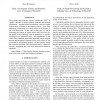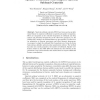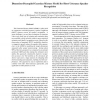26 search results - page 3 / 6 » Language-independent constrained cepstral features for speak... |
ICASSP
2009
IEEE
13 years 11 months ago
2009
IEEE
The popular mel-frequency cepstral coefficients (MFCCs) capture a mixture of speaker-related, phonemic and channel information. Speaker-related information could be further broke...
NOLISP
2005
Springer
13 years 10 months ago
2005
Springer
The best performing systems in the area of automatic speaker recognition have focused on using short-term, low-level acoustic information, such as sepstral features. Recently, vari...
ICASSP
2008
IEEE
13 years 11 months ago
2008
IEEE
This work investigates the use of missing data techniques for noise robust speaker identification. Most previous work in this field relies on the diagonal covariance assumption ...
ICB
2007
Springer
13 years 8 months ago
2007
Springer
Abstract. Spectral subband centroids (SSC) have been used as an additional feature to cepstral coefficients in speech and speaker recognition. SSCs are computed as the centroid fre...
ICPR
2010
IEEE
14 years 4 hour ago
2010
IEEE
The Gaussian Mixture Model (GMM) is often used in conjunction with Mel-frequency cepstral coefficient (MFCC) feature vectors for speaker recognition. A great challenge is to use ...



